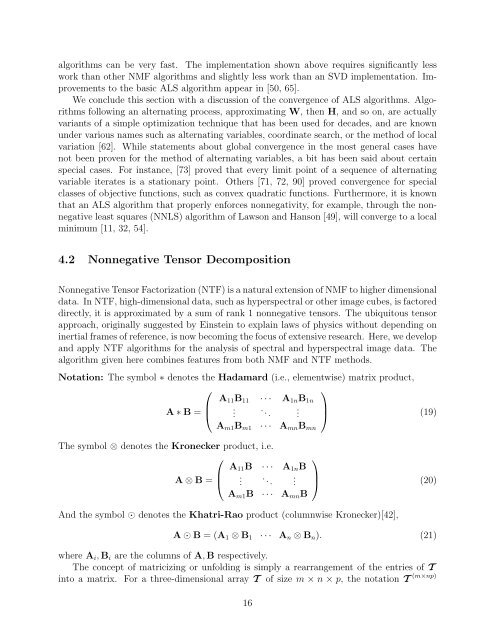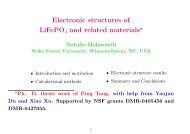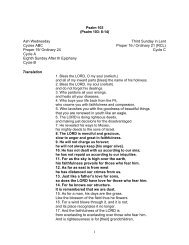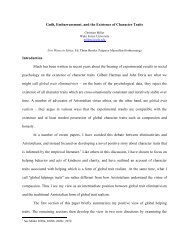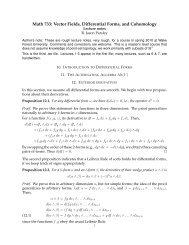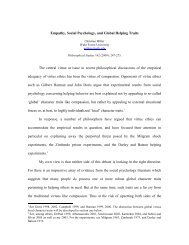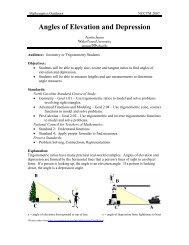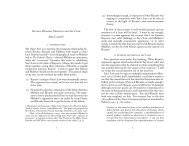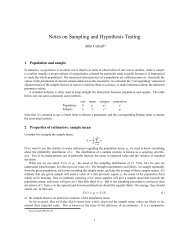Nonnegativity Constraints in Numerical Analysis - CiteSeer
Nonnegativity Constraints in Numerical Analysis - CiteSeer
Nonnegativity Constraints in Numerical Analysis - CiteSeer
You also want an ePaper? Increase the reach of your titles
YUMPU automatically turns print PDFs into web optimized ePapers that Google loves.
algorithms can be very fast. The implementation shown above requires significantly lesswork than other NMF algorithms and slightly less work than an SVD implementation. Improvementsto the basic ALS algorithm appear <strong>in</strong> [50, 65].We conclude this section with a discussion of the convergence of ALS algorithms. Algorithmsfollow<strong>in</strong>g an alternat<strong>in</strong>g process, approximat<strong>in</strong>g W, then H, and so on, are actuallyvariants of a simple optimization technique that has been used for decades, and are knownunder various names such as alternat<strong>in</strong>g variables, coord<strong>in</strong>ate search, or the method of localvariation [62]. While statements about global convergence <strong>in</strong> the most general cases havenot been proven for the method of alternat<strong>in</strong>g variables, a bit has been said about certa<strong>in</strong>special cases. For <strong>in</strong>stance, [73] proved that every limit po<strong>in</strong>t of a sequence of alternat<strong>in</strong>gvariable iterates is a stationary po<strong>in</strong>t. Others [71, 72, 90] proved convergence for specialclasses of objective functions, such as convex quadratic functions. Furthermore, it is knownthat an ALS algorithm that properly enforces nonnegativity, for example, through the nonnegativeleast squares (NNLS) algorithm of Lawson and Hanson [49], will converge to a localm<strong>in</strong>imum [11, 32, 54].4.2 Nonnegative Tensor DecompositionNonnegative Tensor Factorization (NTF) is a natural extension of NMF to higher dimensionaldata. In NTF, high-dimensional data, such as hyperspectral or other image cubes, is factoreddirectly, it is approximated by a sum of rank 1 nonnegative tensors. The ubiquitous tensorapproach, orig<strong>in</strong>ally suggested by E<strong>in</strong>ste<strong>in</strong> to expla<strong>in</strong> laws of physics without depend<strong>in</strong>g on<strong>in</strong>ertial frames of reference, is now becom<strong>in</strong>g the focus of extensive research. Here, we developand apply NTF algorithms for the analysis of spectral and hyperspectral image data. Thealgorithm given here comb<strong>in</strong>es features from both NMF and NTF methods.Notation: The symbol ∗ denotes the Hadamard (i.e., elementwise) matrix product,⎛⎞A 11 B 11 · · · A 1n B 1n⎜A ∗ B = ⎝.. ..⎟ . ⎠ (19)A m1 B m1 · · · A mn B mnThe symbol ⊗ denotes the Kronecker product, i.e.⎛⎞A 11 B · · · A 1n B⎜A ⊗ B = ⎝.. ..⎟ . ⎠ (20)A m1 B · · · A mn BAnd the symbol ⊙ denotes the Khatri-Rao product (columnwise Kronecker)[42],A ⊙ B = (A 1 ⊗ B 1 · · · A n ⊗ B n ). (21)where A i , B i are the columns of A, B respectively.The concept of matriciz<strong>in</strong>g or unfold<strong>in</strong>g is simply a rearrangement of the entries of T<strong>in</strong>to a matrix. For a three-dimensional array T of size m × n × p, the notation T (m×np)16


